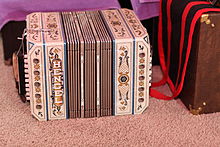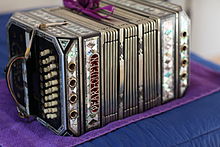- Chemnitzer concertina
-
Chemnitzer concertina 
Classification Free reed aerophone Related instruments Musicians - Li'l Wally
- David Eugene Edwards
- Gary Erickson
- Christy Hengel
- Jim Herda
- Dan Witucki
- Vinny Lech
- Karl Hartwich
- Brian Brueggen
- Gary Brueggen
A Chemnitzer concertina is a musical instrument of the hand-held bellows-driven free-reed category, sometimes called squeezeboxes. The Chemnitzer concertina is most closely related to the Bandoneón (German spelling: Bandonion), more distantly to the other concertinas, and accordions.
Contents
Physical description
It is roughly square in cross-section, with the keyboards consisting of cylindrical buttons on each end arranged in curving rows. Like other concertinas, the buttons travel in a direction approximately parallel to the motion of the bellows, whereas the keys and buttons of an accordion move roughly perpendicular to the motion of the bellows. A strap, usually of leather, is fitted at each end to hold the player's palm against the instrument for playing. Compare to the English concertina where the thumb holds a strap, the little finger is held on a rest, and the remaining three fingers press the keys. The instrument is bisonoric, meaning that each button corresponds to two notes: one when the bellows is compressed, and another when it is expanded. On most instruments, two or more (and as many as five) reeds sound for each note. The tones produced are either in octaves, unison, or in some combination thereof.
Internal construction is different from other concertinas in that the action more closely resembles that of an accordion, and that the reeds are of steel (rather than brass) and are often fixed in groups of twenty or more to long zinc or aluminum plates, rather than to individual frames. This arrangement resembles that of the Russian accordion, the Bayan.
History
Sources differ whether German inventor Carl Friedrich Uhlig created his first concertina after seeing Charles Wheatstone's instrument of the same name, or whether the two men invented their instruments concurrently and independently. Uhlig's patent dates to 1834, and while Wheatstone patented a related instrument, the symphonium in 1829, he did not patent an instrument under the name "Concertina" until 1844.
Types
Uhlig's first instrument had five buttons on each side, but the keyboard was quickly expanded and as it did so, it diverged into different lineages. Heinrich Band's was sold under the name Bandonion. Several other German instruments were sold under the name "Concertina" (or Konzertina), and their keyboard systems were given names based on their creators, as with Band and Scheffler, or their city of origin, as with the Carlsfelder and Chemnitzer systems.
Strictly speaking, the Chemnitzer layout is one of 38, 39, 51 or 52 buttons, or one of the American expanded versions of the 52-button system. Especially in English-speaking countries, the term Chemnitzer is frequently applied to any of the square German concertinas that are not Bandonions.
In the United States, especially in the Midwest, where other concertina types are not as well-known as the Chemnitzer concertina, it may be called simply a "Concertina."
Innovations
The most notable innovations to the internal construction of the Chemnitzer concertina were made by German-American instrument builders in Chicago: Ernest Glass patented an aluminum action in 1912 (U.S. Patent 1,024,771), which was quicker and quieter than earlier wooden actions; his son Otto further improved this action in 1928 (U.S. Patent 1,737,839). Otto Schlicht patented an action in 1932 (U.S. Patent 1,890,830) which improved the pivot method of the action levers and allowed action levers to be manufactured by bending metal stock rather than by die stamping. In 1910, prior to these improvements, Robert Leppert was issued a patent (U.S. Patent 978,460), the specification of which describes in detail an action containing jointed levers between keys and pallets, however the claims of the patent only relate to a means of expression control also described; it is not clear whether Leppert actually invented the action arrangement.
Many American and Italian builders of the 20th century began using reed and reedblock types similar to those used in accordions as a cost-saving measure and to facilitate repair, however many players consider these instruments to be inferior, as they often lack the traditional sound.
Repertoire
The Chemnitzer concertina has been predominantly used in folk music, especially Polka music played in Central and Eastern Europeans and by nineteen- and twentieth century immigrants to the United States from those regions. However the instrument, especially in its 52-button and larger versions, is capable of performing in other musical contexts.
External links
- Squeezebox, an open repository of squeezebox knowledge on Wikia.
- United States Concertina Association
- Erickson
References
- Dunkel, Maria (1996). Bandonion und Konzertina: Ein Beitrag zur Darstellung des Instrumententyps (2nd ed.). München-Salzburg: Musikverlag Emil Katzbichler. ISBN 3-87397-070-8
Bayan · Button · Cajun accordion · Chromatic button accordion · Diatonic button accordion/Melodeon · Flutina · Garmon' · Livenka · Piano accordion · Saratovskaya Garmonika · Schrammel accordion · Schwyzerörgeli · Steirische Harmonika · TrikitixaConcertinas Categories:- Keyboard instruments
- Free reed aerophones
- Sets of free reeds
- Chemnitz
- German musical instruments
Wikimedia Foundation. 2010.



